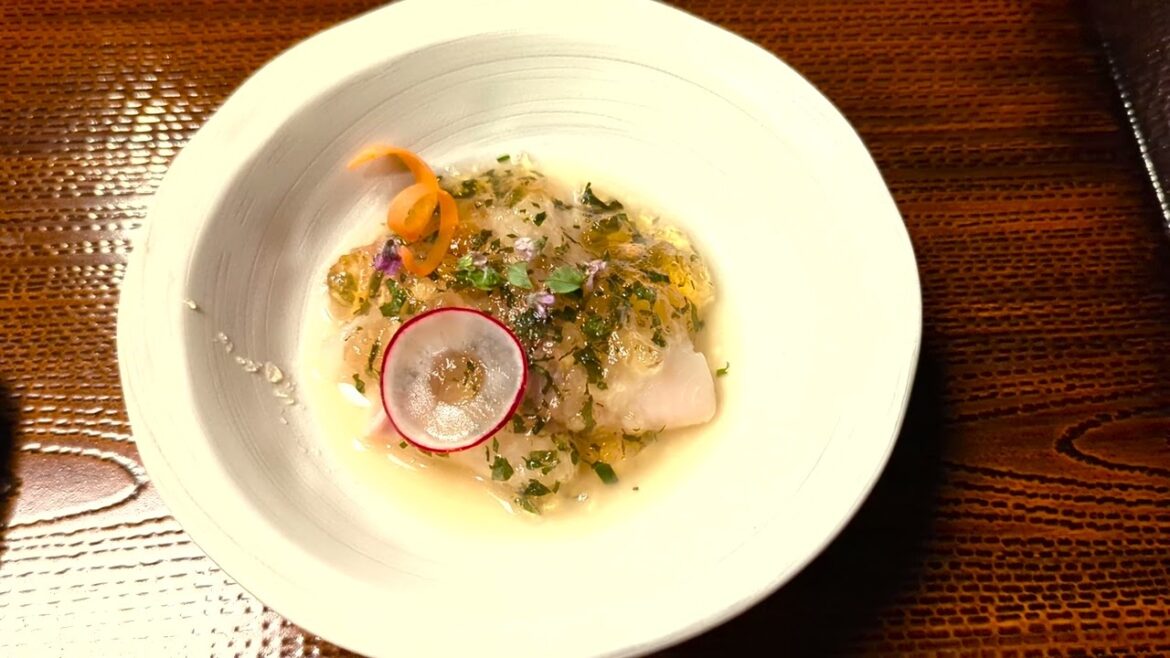This was our third stay at Sui Suwako (萃sui 諏訪湖), a boutique luxury ryokan with just 8 rooms located in Laka Suwa, Nagano, Japan (長野県諏訪湖.) The explanation, however, was all in Japanese, so here is a description of each course (to the best of my ability!)…
COURSE 1 – SAKIZUKE (先付 – Appetizer):
* Green Peas Chawanmushi (グリーンピース茶碗蒸し – Green Peas “Chawanmushi” Savory Egg Custard)
* Green Asparagus Fukimiso-ae (グリーンアスパラ蕗味噌和え – Green Asparagus with Fuki-miso sauce (Shinshu Miso and Butter Burstalk))
* Shinshu-gyu Momo Roast to Negi no Karashi Miso-ae (信州牛ももロースと葱の辛子味噌和え – Roasted Shinshu Beef with Spring Onion and Mustard Miso Sauce)
* Yomogi-fu Dengaku (蓬麩田楽 – Japanese Mugwort Wheat Gluten with Sweet Miso Soybean Paste)
* Soramame Tsuya-ni (蚕豆艶煮 – Small Broad Beans simmered in Mirin and Sugar)
* Kamo Roast (鴨ロース – Low temperature-cooked Duck)
* Nanohana Kobujime (菜の花昆布締め – Konbu Sea Kelp-cured Young Ferns of a Rapeseed Plant)
* Sudori Myoga (酢取り茗荷 – Japanese Ginger)
* Koi Nanban-zuke (鯉南蛮漬け – Nanban sauce-vinegared Carp)
* Sakura-fu (桜麩 – Wheat Gluten shaped like a Sakura Cherry Blossom)
* Jidori Kosodemaki (地鶏小袖巻き – Chicken wrapped in “Dashimaki Tamago” (Japanese Rolled Omelette) to look like a Kosode, which is a short-sleeved garment and the predecessor of the Kimono)
* Wakasagi no Kanro-ni Kinome-ae (公魚の甘露煮木の芽和え – Japanese Smelt simmered in a mix of soy sauce, mirin or mizuame syrup and the Young Leaves of a Sansho Plant)
COURSE 2 – OWANGAWARI (お椀替り – Soup Dish):
* Sawani Nabe (沢煮鍋 – Hakuba-raised Pork with Seasonal Vegetables)
* Alternate: Jidori Tsukune (地鶏つくね – Minced and kneaded Chicken)
COURSE 3 – AGEMONO (揚げ物 – Fried Dish):
* Wakasagi Tempura (公魚天ぷら – Japanese Smelt Tempura)
COURSE 4 – OTSUKURI (御造り – Seasonal Sashimi):
* Shinshu Daio Iwana (信州大王岩魚 – Daio Iwana Char)
– Ponzu Jule (ポン酢ジュレ – Ponzu (Citrus Sauce) Jelly)
COURSE 5 – OTSUKURI #2 (御造り – Seasonal Sashimi):
* Tenshi no Ebi (天使の海老 – Angel Shrimp)
* Nama no Ebi (生の海老 – Raw Shrimp)
* Hotate (帆立 – Scallops)
* Yaki Kuruma-ebi (焼き車海老 – Grilled Tiger Shrimp)
COURSE 6 – YAKIMONO (焼き物 – Grilled Dish):
* Shinshu Salmon Yakibitashi (信州サーモン焼き浸し – Shinshu Salmon grilled with vinegared dashi broth)
COURSE 7 – SHUNSAI (旬彩 – Seasonal Dish)
* Takenoko Konome-yaki (筍木の芽焼き – Grilled Bamboo Shoots with the Young Leaves of a Sansho Plant)
COURSE 8 – NAKAZARA (中皿 – Small, Middle Dish):
* Shinshu Soba (信州蕎麦 – Shinshu Soba buckwheat noodles)
– Wasabi no Hana (山葵の花 – Wasabi Flowers)
– Katsuo Bushi (かつおぶし – Shaved & dried Bonito flakes)
COURSE 9 – HINOMONO (火の物 – Main Dish):
* Shinshu Premium Gyu Kata Rosu Shabu Shabu (信州プレミアム牛肩ロースしゃぶしゃぶ – Shinshu Premium Beef Shoulder Loin Shabu Shabu hot pot)
* Tai Shabu Shabu (鯛しゃぶしゃぶ – Red Sea Bream Shabu Shabu hot pot)
– Maitake (舞茸 – “Hen-of-the-woods” Maitake Mushroom)
– Negi (葱 – Spring Onions)
– Shungiku (春菊 – Crown Daisy)
– Sakura-fu (桜麩 – Wheat Gluten shaped like a Sakura Cherry Blossom)
COURSE 10 – GOHAN (ご飯 – Rice Dish):
* Fuki to Abura-age no Takikomi Donabe Gohan (蕗と油揚げ土鍋ご飯 – Rice cooked in a clay pot with thin, deep-fried Tofu and Butterbur plant stems)
* Awase Misoshiru to Aosa (合わせ味噌汁とあおさ – Awase “Mixed” Miso soybean paste soup with Aosa Seaweed. Awese Miso is something of a cross between White and Red Miso)
COURSE 11 – KOUNOMONO (香の物 – Pickled Vegetables):
* Takuwan (沢庵 – Pickled Daikon Radish)
* Nozawana (野沢菜 – Japanese Mustard Leaves)
* Narazuke (奈良漬 – Cucumber that’s been pickled repeatedly in Sake Lees)
COURSE 12 – KA (菓 – Sweets):
* Yomogi Bavarois (蓬ババロア – Mugwort Bavarois / Bavarian Cream)
– Whipped Cream (ホイップクリーム)
– Anko (あんこ – Sweet Red Bean Paste)
– Ichigo (苺 – Strawberries)

